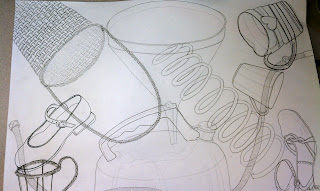There are many ways to create emphasis by using contrast.
1. When most of the elements are dark, a light form breaks the pattern and becomes a focal point.
2. When most of the elements are muted or soft-edged, a bold contrasting pattern will become a focal point.
3. In an overall design of distorted expressionistic forms, the sudden introduction of a naturalistic image will draw the eye for its very different style.
4. Text or graphic symbols will be a focal point.
5. When the majority of elements are shapes, an irregular line will stand out.
These are just some of the many possibilities contrast can be used to create emphasis.

This is the "Mona Lisa" by Leonardo da Vinci. It holds many of the ways contrast is used to produce emphasis. Obviously the woman in the portrait is the focal point but in order to enhance this emphasis, Leonardo included many other hints. The first is he brightens her face, chest and hands against the background. Lastly, the background is out of focus and blurred where she is sharp and in focus. By using these techniques, it is more clear to the viewer that she is the focal point and not something in the background.











































